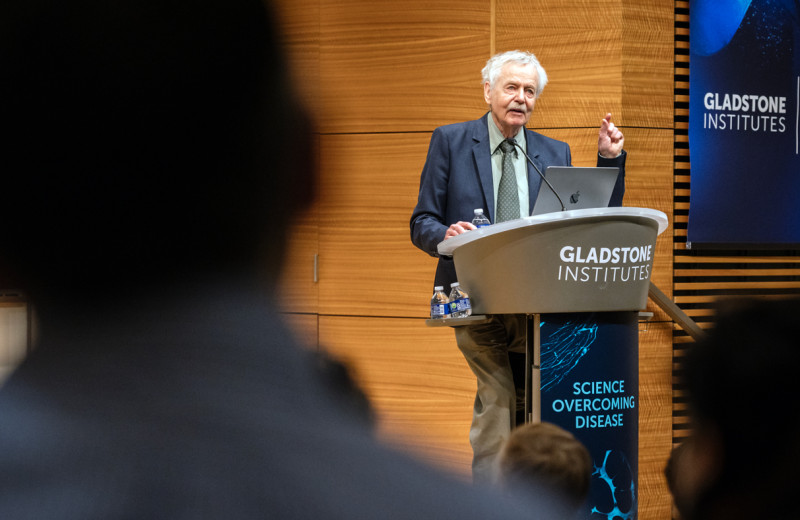Gladstone NOW: The Campaign Join Us on the Journey✕

Kathleen is a graduate student who shares her time between Bruce Conklin’s and Katie Pollard’s labs. She joined Gladstone 2 years ago, at the end of the first year of her PhD education at UC San Francisco. She completed her undergraduate degree in biomolecular engineering at the Milwaukee School of Engineering in Wisconsin.
What brought you to Gladstone?
In my first year of graduate school, I rotated with Bruce Conklin and Katie Pollard and decided I wanted to join their labs to pursue my interests in genomics, genome editing, and bioinformatics.
What do you like about Gladstone?
Gladstone is a nice place to work because it’s filled with great people, has a lot of resources, and best of all, it offers free coffee!
Were you interested in science as a child?
Yes, I was always really interested in animals and the science of different animals. In elementary school, I wrote a report about sea sponges because I found them so fascinating. However, when I was younger, I didn’t really think I would go into science but rather thought I might go into history or foreign languages. But my mom is a science teacher and I had a fantastic physics teacher in high school. Learning from them encouraged me to look into a science-based major in college, which is essentially how I got started in science.
Why did you decide to go to graduate school?
I worked for the Centers for Disease Control and Prevention after finishing my undergraduate degree, at which time I wasn’t sure if I wanted to go to graduate school. During this job, I really missed research and working in basic science, as I had done research during undergrad, so I started looking into different options. I wanted to continue doing research and in the future move into leadership positions in the biotech industry, so a PhD seemed like the best path for me.
What or who influenced your decision to work in science?
My mom definitely encouraged me to look into science. I worked in Debra Newman’s lab at the Blood Research Institute in Wisconsin, and she was probably the first person who encouraged me to consider a PhD, a route that had never really occurred to me until then. Finally, my undergrad senior thesis advisor, Katerina Midelfort, truly helped me make the final decision about pursuing a research degree.
What do you do when you are not working?
I really enjoy trying new things—so you name it, I’ve probably tried it. My favorite thing to do is probably hanging out with my dog Frodo. He’s a puggle, which is a pug and beagle mix, and one of the smartest dogs I have ever encountered. We like to go for hikes and to the beach together, he’s a great swimmer! I also really love to travel, as I enjoy learning new languages and exploring new cultures. I’m currently learning how to kitesurf with my fiancé, and just learned how to stand up on the board. I also enjoy rock climbing, both indoor and outdoor, and my goal is to someday climb a 13a indoor route. Being from Wisconsin, I really appreciate the weather here, so lots of my time not working is spent outside. In the winter, I love to ski! I also love to read, and sometimes the books I read give me ideas about things to think about in my research.
If you could learn to do anything, what would it be?
Recently, I’m really interested in learning how to scuba dive. I think octopuses are really interesting and I want to go see them in their native environment! It’s also a good excuse to go to Hawaii and other beautiful places.
What is your hidden/unique talent?
I’m a pretty good water skier! Wisconsin has lots of lakes, so a popular summer activity is to visit a friend’s lake house and go water skiing, which is how I learned.
Name one thing that not many people know about you.
People might not know that I’ve skied in Hokkaido, Japan’s northernmost main island.
If you could meet any scientist from any point in time, who would it be and why?
This is a tough question because there are many, and because there are many I probably don’t know about since women in science (and other fields) have frequently disappeared from history. I think it would be really interesting to meet Rosalind Franklin, who was integral to the discovery of the helical structure of DNA. Jane Goodall would also be very interesting to meet. I would love to discuss where they imagined their field was headed at the time, and see what they thought of where the field is now.
Want to Join the Team?
Our people are our most important asset. We offer a wide array of career opportunities both in our administrative offices and in our labs.
Explore CareersA Sculptor of Modern Regenerative Medicine
A Sculptor of Modern Regenerative Medicine
Among his myriad accomplishments, Rudolf Jaenisch—winner of the 2025 Ogawa-Yamanaka Stem Cell Prize—was the first to demonstrate the potential of induced pluripotent stem cells to treat disease.
Awards Ogawa Stem Cell Prize Profile Regenerative Medicine Stem Cells/iPSCsMeet Gladstone: Shijie Wang
Meet Gladstone: Shijie Wang
Shijie Wang, a postdoctoral scholar in Steve Finkbeiner’s lab, uses artificial intelligence, robotics, and stem cell technologies to uncover how brain cells die in neurodegenerative diseases like Alzheimer’s and Parkinson’s.
Profile Neurological Disease Finkbeiner Lab AI Robotic MicroscopyMeet Gladstone: Oscar Yip
Meet Gladstone: Oscar Yip
Oscar Yip is advancing Alzheimer’s research in Yadong Huang’s lab at Gladstone while drawing inspiration from his family, community, and his broader goal of helping patients.
Graduate Students and Postdocs Profile Alzheimer’s Disease



